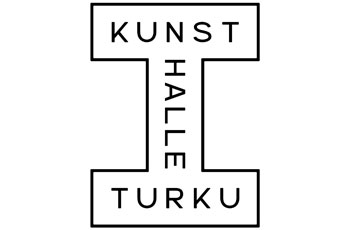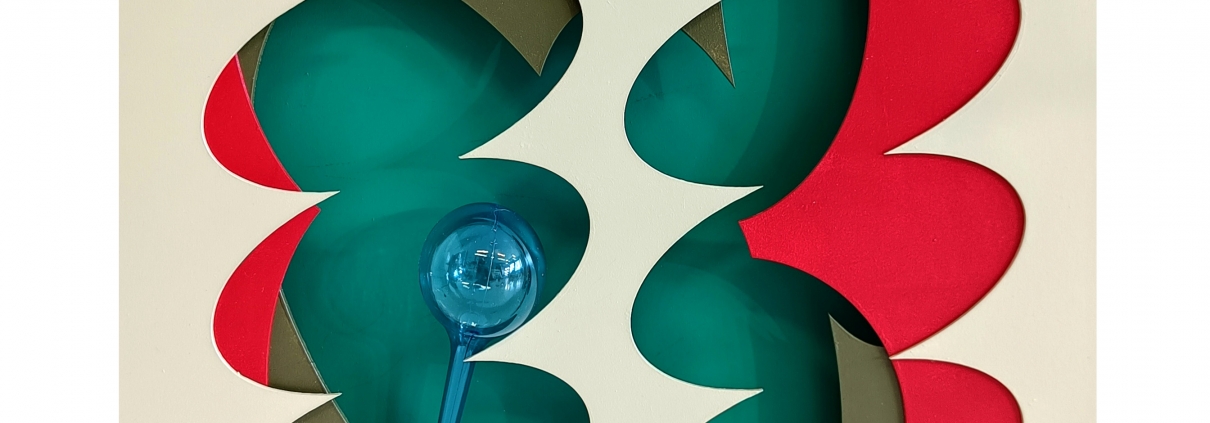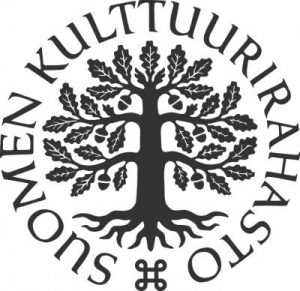In Kaija Hinkula’s exhibition Gardener, colourful (nurtured?) painting objects and the gardener undefined actions are at the center of the whole. The works consist of sculptural paintings combined with objects used in the care of green plants, such as watering balls and spikes or parts of a mini greenhouse. The works cut out of board repeat an abstract pattern associated with seeds and clouds, through which inquisitive figures peek.
Curiosity, experimentation, play and expanding painting into the undefined are essential in Hinkula’s work. The works are spatial, sculptural, videos, ensembles, observations, proposals. Throughout the process, the artist has reflected the power of dreaming and imagination, pondering the concept of ‘realism’ and what it actually means. Hinkula thinks that fantasizing is not an escape from reality, but a resource and necessity in the world – a breeding ground for freedom and new ideas, for the possibilities and potential of being other. Hope and the possibility of imagination encourage new perspectives and a different way of seeing the world, which is inspiring and necessary in the dystopian atmosphere of today.
The new series of works serves a metaphor for nurturing and feeding fantasies. The references to gardening can be seen as a metaphor for human development and the ability to imagine the new world. The seeds symbolise processes of growth and change, hopefulness and confidence in the future. Painting is a garden of possibilities, where different species intersect and give birth to the unprecedented.
Kaija Hinkula (b.1984) holds a Master of Fine Arts degree from the Academy of Fine Arts Helsinki.
Her works can be found in the art collections of HAM and the State Art Collection.
www.kaijahinkula.com / www.instagram.com/kaijahinkula
About nurturing and caring for real and imaginary gardens – the abundance of dreams, pleasure and play
Anna Jensen:
The garden always bursts into splendour. After a harsh winter, the snow melts and through the black soil, stalks of green emerge. Flowers burst from the buds, their brilliance attracting wildlife, pollinators, glittering beetles and bees in fluffy striped suits. The pollen spreads on their tiny feet, the plants fertilise, multiply, prepare to rise again, attracted by the sun, through the clammy soil, lush, fragrant, colourful, generous.
But a garden does not bloom alone, it needs a gardener to help it. A gardener tends, waters, weeds, turns. Imagines, dreams, plans, and then plants, grows and finally collects. The gardener digs, cultivates and knows his plants, his soil and his actions, but also the feelings that arise from them. Aided by myriad tools, jugs, gloves, objects unrecognizable but attractive to one that doesn’t know gardening Now, as part of Hinkula work, these tools both refer to their purpose and become an entirely new, purely aesthetic material. The distinction between the real and the invented narrows and the spectrum of forms of living expands. With gardening, the relationship with the land, and thus with the earth, becomes concrete and tangible, while on the other hand, the utopian dimensions of the relationship with the world rise to the surface.
A garden is a vision, a paradise and a dream. It is the creation of its gardener, but also the result of chance, of exposure to circumstances and system that operates under the conditions of the many different powers. The garden is a fiction that becomes reality as the seeds begin to sprout. The garden is a world of opposites, where the inevitability of death meets the miracle of rebirth, new and repetitive, endlessly repeated and requiring repetition. The garden is a demarcation between chaos and order, work and care, and a place for play, where shapes and colours are in constant flux as the world around them changes.
Kaija Hinkula’s Gardener extends this serious play into the realm of visual art. Borrowing from the aesthetics of gardens and yards and utilizing green plant care supplies, the works foster curiosity and playfulness, building a world of their own that surprises, amuses and delights. Hinkula’s garden serves as a metaphor for the human capacity to evolve and imagine a new kind of world. By nurturing the garden, we nurture playfulness and imagination, we enjoy change, new possibilities, anticipation of the future. Tending a garden is proof that there is a tomorrow.
Gardens are associated with expectation, wild exuberance, beauty and horror: the potential for blossoming and decay, the sweetness of berries and the worms and scavengers that burrow in the soil. But the tenderly gardening carer is also a orchardist, a despotic garden’s ruler, weeding out the unwanted, peeling and digging with sharp claws, puncturing the soil and fruit surface, poisoning and rotting in his compost. The garden is a paradise, but in paradise there may lurk a snake, or someone who peers between the layers of a painting or pokes his paws through the ornamentation that pierces the surface.
Gardens combine dreaming and realism: imagination meets soil, air, sun, water and the gardener’s gentle hands to produce shoots and seedlings from the material form of dreaming. The garden is a complex, symbiotic system of its own, and as a phenomenon full of contradictions: work and pleasure, lazing in the shade and sweaty toil, privilege and duty. Gardening is pleasure and sweat and dirt, real and metaphoric: when Voltaire writes at the end of Candide that ‘One must cultivate one’s own garden’, it is not just a question of growing plants, but of creating one’s own world, developing aesthetic understanding and nurturing one’s own vision and curiosity.
The gardener defends the garden, cultivates it, nurtures its constant change and renewal. Like making art, gardening is work, but it is also play. It takes place between the tangible and the material and the what is in the state of becoming imagined, still to come. It is a matter of making something into something that is, of giving birth: artists and gardeners imagine the world to come for others. The work of the artist and the gardener is to fill what is not yet there with what is imagined and to give it to others to live, to experience, to enjoy, to taste, to see.
Curiosity, experimentation, play, colour, and the extension of painting into the undefined are central to Kaija Hinkula’s work. The works are spatial, sculptural, videos, ensembles, observations, suggestions, and questions. They materialize joy and give it physical forms, making visible that pleasure and humor are not trivial, but have a subversive power. Painting is a garden of possibilities, where different genres intersect and give birth to the unprecedented. Hinkula’s exhibition contributes to the current discourse on gardens, extending it from literature to visual art. Where Olivia Laing, in her latest work The Garden Against Time, describes gardens as havens of safety, fertile paradises and places of secrets and possibilities, but also of exclusion and privilege, and Sheila Heti, in Pure Colour, describes how, after the world’s first draft, a flourishing garden sprouts everywhere, “The entire earth will be a garden sprouting forth, opening with the sun and closing with the moon, and the plants will not remember how we cut them in the first draft.” Hinkula ponders the question through colour and form. The beauty of this is that the viewer can experience thinking spatially and physically, entering the garden of works.
Anna Jensen
Jensen (DA) is a Helsinki-based curator, researcher and writer who fell head over heels in love with Hinkula’s works at first encounter, and this love has been deepening ever since.
Kaija Hinkula’s Gardener is on display in Kunsthalle Turku, Iso Galleria 5.7. – 25.8.2024, from Wednesday to Friday 12-18, Saturdays and Sundays 12-16. Address: Vanha Suurtori 5, Turku









